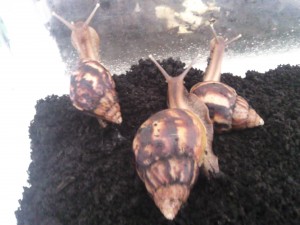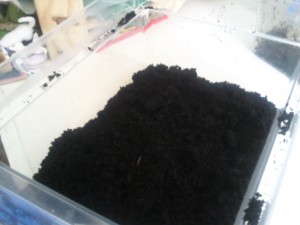How to Clean Out A Giant Land Snail’s Vivarium
 Many pet giant land snails will live in some kind of vivarium or tank. Vivariums are ideal homes for many exotic animals as they enable easy access to the creature, and as many vivariums are transparent, it makes it easy for you to safely study your pet.
Many pet giant land snails will live in some kind of vivarium or tank. Vivariums are ideal homes for many exotic animals as they enable easy access to the creature, and as many vivariums are transparent, it makes it easy for you to safely study your pet.
Depending on the size and species of your snail, you will need a big, medium or small vivarium. If you’re unsure as to what size vivarium to get for your pet, go for the bigger size; it’s better for an animal to have too much room than too little. In order for your pet to be happy and healthy, the vivarium will need cleaning out regularly.
Here’s an easy guide to cleaning out your giant land snail’s vivarium tank:
Firstly remove the animals into a safe place. With my giant land snails I have two vivariums, and when I clean out one vivarium, they go into the other.
Next remove any food, plants, toys e.t.c. You may need to clean these as well. If your pet has a cuttle fish bone (all giant land snails should) it will need washing in fresh, clean water.
You should now just have the vivarium with the substrate or medium in. i.e the compost. You’ll either need a place you can tip this or a bag you can put it in. If the vivarium or tank is too big or heavy to pick up or move then you’ll need a trowel or scoop so you can scoop out the substrate.
Remember to check through the substrate for eggs before disposing of it. It is illegal to release giant land snails or their eggs into the environment whether it is intentional or not. Even if you just have one snail, you should still look out for eggs, as these snails are hermaphrodites, and in cases they can do self-fertilisation.
After you’ve removed the substrate and medium, it is a good idea to swish some water about, as this will remove any soil or excrement on the walls. Then tip the water out. Remember, because giant land snails live in quite moist conditions it doesn’t matter if you don’t dry off the walls, floor and roof of the vivarium before continuing.
 Now put some sort of medium or substrate into the vivarium. It should be about 2 inches thick to allow the snails to burrow.
Now put some sort of medium or substrate into the vivarium. It should be about 2 inches thick to allow the snails to burrow.
Using a sprayer, mist water over the substrate. Now replace your snail’s cuttlefish bone and any scenery your snail has.
Put fresh food for your snail into the freshly cleaned out vivarium.
And finally put your giant land snails back and watch them explore!
 July 30, 2010
·
July 30, 2010
·  Maddia (Admin) ·
Maddia (Admin) ·  3 Comments
3 Comments
 Tags: clean out tank, clean out vivarium, Giant Land Snails, mollusk care, Pets, vivarium · Posted in: Giant Land Snail Care, Giant Land Snail Information
Tags: clean out tank, clean out vivarium, Giant Land Snails, mollusk care, Pets, vivarium · Posted in: Giant Land Snail Care, Giant Land Snail Information



3 Responses
That’s a good idea about having two vivariums as then the giant land snails have somewhere to go whilst their home is being cleaned. Thanks :)
I didnt realise you had to replace the compost each week. Is it possible that the snails could get diseases/shells could come off e.t.c??
Also my snails dont seem to be very active..? I dont know if its to do with the cold weather, but i have an old tropical fish tank with a bulb that i turn on when their tank is cold. Thanks (:™
Hi, ideally the compost should be replaced at least once or twice a month, but many owners choose to do it every week or two as it keeps it cleaner – in the winter months I find it’s better to only change the substrate about once a month as not only will new substrate be cold, but also many snails burrow down to keep warm, and so should not be disturbed if possible. I am not aware of any diseases that they can contract from not having the compost changed weekly; but this doesn’t mean you shouldn’t clean it out – you should! However, there are quite a few insects and organisms (these may lay eggs in the soil too) that may be in the substrate which will attack your snail and can cause disease, so this is one reason for regularly changing the compost. One way to decrease the risk of disease in the vivarium is to remove any old food before it has the chance to go mouldy.
In the winter months, I find that my snails aren’t very active either; this is because of the colder temperatures and the possibility of your snails going into hibernation. If they have started hibernating there are a number of things you can do to get them out of it, including bathing them with warm water. Many owners choose to leave their snails to come out of hibernation naturally. If a membrane has formed over the end of the shell this is an indication of hibernation.
Now, you mention you have a bulb in your tank; I’m guessing this gives out more light than heat? Giant land snails don’t need a lot of light, as they’re nocturnal, but their vivarium or tank should be kept at a constant temperature with a heat gradient – this can be achieved with the use of a heat mat covering 1/2 to 2/3 of one side of the vivarium. (You should always use a heat mat with a thermostat so you can control the temperature). The temperature should be between 20°C and 27°C (definitely not over 29°C). Many snails will hibernate if the temperature is below 18°C. Please note: different species of giant land snail need different temperatures to remain active.
Hopefully this has helped :)